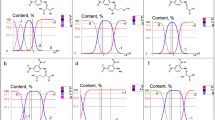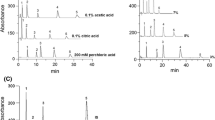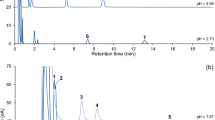Abstract
A rapid and sensitive method for the quantitative determination of pipecolic acid (PA), one of the three cyclic secondary imino acids present in mammalian brain is described. The quantification and identification of PA are accomplished in rat and mouse brain using high performance liquid chromatography with electrochemical detection (LCEC) and nipecotic acid (NPA) as an internal standard. The cyclic imino acids are derivatized with 2,4-dinitrofluorobenzene (DNFB) to dinitrophenyl derivatives. The remaining time for LCEC analysis is less than 30 min and the limit of sensitivity is in the lower picomole range. The levels of PA found in rat and mouse brain are comparable to those reported using gas chromatography/mass spectrometry. The regional distribution of PA shows higher concentrations of PA in hypothalamus, pons-medulla oblongata and cerebellum. The present results demonstrate that LCEC is sensitive enough to determine endogenous levels of PA in mg amounts of rodent brain tissue. Due to its simplicity and rapidity, the technique represents an alternative to existing methods. This method can also be used for determination of PA in CSF, blood or urine of hyperipecolic patients.
Similar content being viewed by others

References
Rothstein, M., andMiller, L. L. 1954. The conversion of lysine to pipecolic acid in the rat. J. Biol. Chem. 211:851–858.
Boulanger, P. Osteux, R. Sacquet, E., andCharlier, H. 1969. La degradation de lal-lysine le rat germ-free. Biochim. Biophys. Acta 184:338–344.
Grove, J. A., Gilbertson, T. J., Hammerstedt, R. D., andHenderson, L. M. 1969. The metabolism ofd- andl-lysine specifically labeled with15N. Biochim. Biophys. Acta. 184:329–337.
Higashino, K., Fukioka, M., andYamamura, Y. 1971. The conversion ofl-lysine to saccharopine and alpha-aminoadipate in mouse. Arch. Biochem. Biophys. 142:606–614.
Schmidt-Glenewinkel, T., Nomura, Y., andGiacobini, E. 1977. The conversion of lysine into piperidine, cadaverine, and pipecolic acid in the brain and other organs of the mouse. Neurochem. Res. 2:619–637.
Chang, Y-F. 1976. Pipecolic acid pathway: the major lysine metabolic route in the rat brain. Bioch. Bioph. Res. Comm. 69:174–180.
Chang, Y-F. 1978. Lysine metabolism in the rat brain: the pipecolic acid-forming pathway. J. Neurochem. 30:347–354.
Chang, Y-F. 1978. Lysine metabolism in the rat brain: blood-brain barrier transport, formation of pipecolic acid and human hyperpipecolatemia. J. Neurochem. 30:355–360.
Chang, Y-F. 1982. Lysine metabolism in the human and the monkey: demonstration of pipecolic acid formation in the brain and other organs. Neurochem. Res. 7:577–588.
Giacobini, E., Nomura, Y., andSchmidt-Glenewinkel, T. 1980. Pipecolic acid: origin, biosynthesis and metabolism in the brain. Cell. Molec. Biol. 26:135–146.
Nomura, Y., Schmidt-Glenewinkel, T., andGiacobini, E. 1978. In vitro formation of piperidine, cadaverine and pipecolic acid in chick and mouse brain during development. Develop. Neurosci. 1:239–249.
Nomura, Y., Schmidt-Glenewinkel, T., andGiacobini, E. 1980. Uptake of piperidine and pipecolic acid by synaptosomes from mouse brain. Neurochem. Res. 5:1163–1173.
Nomura, Y., Okuma, Y., Segawa, T., Schmidt-Glenewinkel, T., andGiacobini, E. G. 1979. A calcium-dependent, high potassium-induced release of pipecolic acid from rat brain slices. 33:803–805.
Nishio, H., Giacobini, E., andOortiz, J. 1982. Accumulation, elimination, release and metabolism of pipecolic acid in the mouse brain following intraventricular injection. Neurochem. Res. 7:373–385.
Kasé, Y., Takahama, K., Hashimoto, T., Kaisaku, J., Okano, Y., andMiyata, T. 1980. Electrophoretic study of pipecolic acid, a biogenic imino acid, in the mammalian brain. Brain Res. 193:608–613.
Giacobini, E., andGutierrez, M. D. C. 1983. GABA and pipecolic acid, a possible reciprocal modulation in the CNS. Pages 571–580,in Hertz, L., Kvamme, E., McGeer, E., andSchousboe, A. (eds.) Glutamine, Glutamate and GAB in Central Nervous System, Vol. 7, Alan R. Liss, New York.
Kasé, Y., Kataoka, M., Miyata, T. andOkano, Y. 1973. Pipecolic acid in the dog brain. Life Sci. 13:867–873.
Gatfield, P. D., Taller, E., Hinton, G. G., Wallace, A. C., Abdelnour, G. M., andHaust, M. D. 1968. Hyperpipecolatemia: a new metabolic disorder associated with neuropathy and hepatomegaly: a case study. Can. Med. Assoc. J. 99:1215–1233.
Lawrence, J. M., Herrick, H. E., andCoahran, D. R. 1973. Determination of pipecolic acid by thin-layer chromatography. Analyt. Biochem. 53:317–320.
Danks, D. M., Tippett, P., Adams, C., andCampbell, P. 1975. Cerebro-hepato-renal syndrome of Zellweger. J. Pediatrics 86:382–387.
Burton, B. K., Reed, S. P., andRemy, W. T. 1981. Hyperpipecolic acidemia: clinical and biochemical observations in two male siblings. J. Pediatrics 99:729–734.
Okano, Y., Kataoka, M., Miyata, T., Morimoto, H., Takahama, K. Hitoshi, T., Kasé, Y., Matsumoto, I., andShinka, T. 1981. Simultaneous analysis of pipecolic acid with proline in the brain by selected ion-monitoring technique. Analyt. Biochem. 117:196–202.
Giacobini, E. 1983. Imino acids of the brain. Pages 583–605,in Lajtha, A. (ed.) Plenum Publishing Corp., New York.
Kissinger, P. T., Bruntlett, C. S., andShoup, R. E. 1981. I. Minireview: Neurochemical applications of liquid chromatography with electrochemical detection. Life Sci. 28:455–465.
Jacobs, W. 1982. Use of series dual electrodes for elimination of sample oxygen interference. Current Separations: Bioanalyt. Systems, 3:45–47.
Lajtha, A., Marker, H. S., andClarke, D. D. 1981. Metabolism and transport of carbohydrates and amino acids.in Siegel, G. Et Al. (eds.) Little Brown and Co., Boston.
Author information
Authors and Affiliations
Rights and permissions
About this article
Cite this article
Kim, J.S., Giacobini, E. Quantitative determination and regional distribution of pipecolic acid in rodent brain. Neurochem Res 9, 1559–1569 (1984). https://doi.org/10.1007/BF00964591
Accepted:
Issue Date:
DOI: https://doi.org/10.1007/BF00964591



